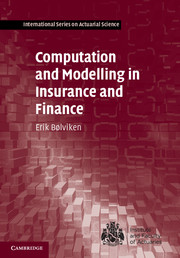Book contents
Preface
Published online by Cambridge University Press: 05 May 2014
Summary
The book is organized as a broad introduction to concepts, models and computational techniques in Part I and with general insurance and life insurance/financial risk in Parts II and III. The latter are largely self-contained and can probably be read on their own. Each part may be used as a basis for a university course; we do that in Oslo. Computation is more strongly emphasized than in traditional textbooks. Stochastic models are defined in the way they are simulated in the computer and examined through numerical experiments. This cuts down on the mathematics and enables students to reach ‘advanced’ models quickly. Numerical experimentation is also a way to illustrate risk concepts and to indicate the impact of assumptions that are often somewhat arbitrary. One of the aims of this book is to teach how the computer is put to work effectively.
Other issues are error in risk assessments and the use of historical data, each of which are tasks for statistics. Many of the models and distributions are presented with simple fitting procedures, and there is an entire chapter on error analysis and on the difference between risk under the underlying, real model and the one we actually use. Such error is in my opinion often treated too lightly: we should be very much aware of the distinction between the complex, random mechanisms in real life and our simplified model versions with deviating parameters. In a nebulous and ever-changing world modelling should be kept simple and limited to the essential.
- Type
- Chapter
- Information
- Computation and Modelling in Insurance and Finance , pp. xxv - xxviPublisher: Cambridge University PressPrint publication year: 2014

